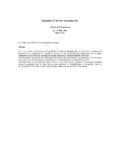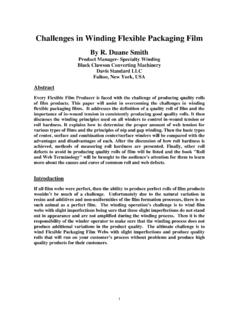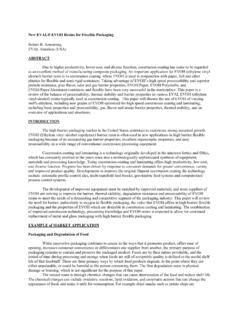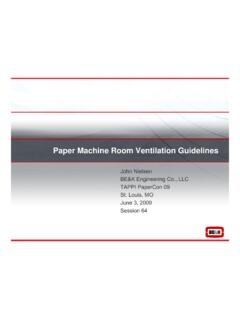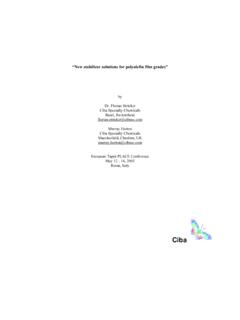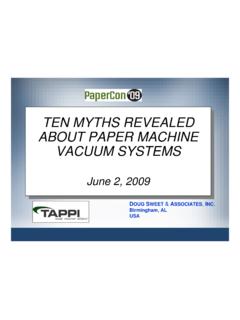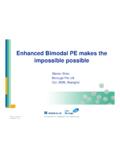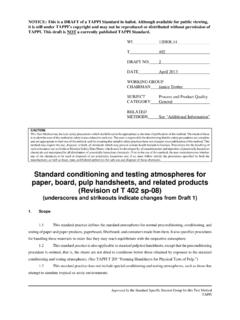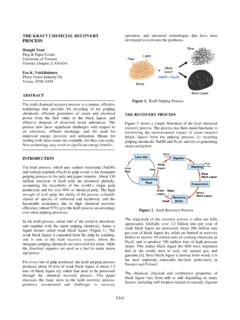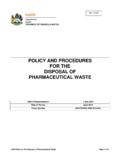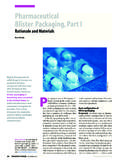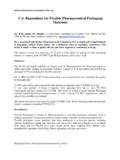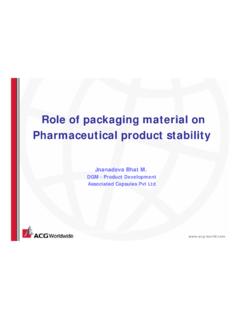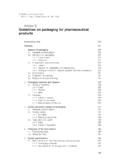Transcription of PVDC – New Developments, New Opportunities
1 pvdc New Developments, New Opportunities Kirk Paisley SolVin, a division of Solvay Advanced Polymers, Alpharetta, Georgia Introduction The information in this presentation will provide basic background information on the use of pvdc resins and coatings in packaging applications. It will also give data on new grades of pvdc resins and latex, which can lead to the development of new packaging films by flexible packaging converters and film manufacturers. Background Polyvinylidene chloride ( pvdc ) resins and coatings have been a part of the flexible packaging world for more than 50 years, with a unique combination of functional characteristics that has found numerous applications. It is available in a variety forms: Aqueous dispersions, or latex, for coating on a number of different film and paper substrates, Extrudable powders, for monolayer or multilayer films and sheet, and Soluble powders, for solvent-based coatings on films.
2 According to 2004 estimates1, approximately 160,000 metric tons of pvdc are used annually around the world in extruded, coextruded, coated and laminated structures. In a study of high barrier packaging films released in late 20052, pvdc was reported to be the leading barrier polymer in high performance packaging films. For example, in dry food packaging , pvdc -coated BOPP films hold a 53% share of barrier films used to package dry foods. Also, the forecasted growth for pvdc -coated PET films is a healthy 9% per year, driven primarily by new applications including lidstock for prepared foods, retort applications, and clear, stand-up pouches. The unique combination of properties offered by pvdc include Protection from moisture loss or gain Protection against oxidation of ingredients Protection from aroma and flavor loss or pickup Aqueous pvdc Dispersion Extrudable pvdc Powder Soluble pvdc Powder Prevention of oil and grease permeation Good seal integrity, using heat seals, high-frequency seals or ultrasonic seals Excellent transparency and gloss Good antifog properties Excellent printing characteristics Good scratch and abrasion resistance pvdc also complies with the requirements for direct food and pharmaceutical contact of regulatory agencies around the world.
3 When it comes to barrier properties, pvdc is different from most other barrier polymers, providing excellent barrier to both oxygen and water vapor while most other barrier polymers offer just one or the other. The gas barrier properties are unaffected by relative humidity, so the performance can be relied on through a wide range of packaging and environmental conditions. All pvdc products on the market are actually copolymers of vinylidene chloride (VDC) and other comonomers. The relative amount of VDC in the copolymer dictates some key properties. With more VDC, the barrier properties are generally better; with less VDC, flexibility usually improves. However, the amount and type of comonomer(s), as well as other additives and processing technology used, will influence other properties such as sealing, surface properties, transparency, gloss, coefficient of friction, etc. New pvdc Developments Even though pvdc has been around for so many years, new grades of pvdc latex and resins have been introduced in recent years that offer improved barrier vs.
4 Standard grades that have been used traditionally. Reductions in both oxygen and water vapor transmission rates are allowing flexible packaging converters the ability to offer higher barrier, lighter-weight, and/or less costly packaging solutions. pvdc Latex for pharmaceutical blister packaging For example, a new grade of pvdc latex was introduced this year for use in pharmaceutical blister packaging . pvdc coatings have been used in this application since the late 60s, with duplex ( pvdc /PVC) and triplex ( pvdc /PE/PVC) structures being the most common ones used. In fact, estimates show that approximately 67% of the barrier blister packaging market uses these pvdc -coated films. Typical coating weights used include 40, 60, 90 and 120 g/m , with the water vapor transmission rate (WVTR) for a typical 120 g/m pvdc -coated PVC film being around g/m d at 40 C and 75% pharmaceutical blister packaging The target of this development was a pvdc latex that would provide twice the water vapor barrier of the standard grades used for pharmaceutical blister packaging , while maintaining the machining properties necessary for the end use.
5 R&D tests as part of this work included evaluations of the various polymers used in pharmaceutical packaging , comparisons of WVTR test methods, and WVTR tests on both flat and thermoformed films. From these studies, several key observations were made: 1. With proper machine setup, the forming properties of most polymers used for pharmaceutical blister packaging behave very similarly. 2. Likewise, the WVTR properties of these same polymers show very similar differences between flat and thermoformed films. Table 1: WVTR of various films before and after thermoforming WVTR @ 40 C/75% RH Film Flat [g/m d] Thermoformed [g/m d] RATIO PVC, 250 m 4 g/m d 9 COC, 190 m COC, 240 m COC, 300 m PCTFE (15 m)/PVC PCTFE (51 m)
6 /PVC pvdc Duplex, 40 g/m New pvdc Triplex, 90 g/m New pvdc Triplex, 120 g/m 3. There is good correlation between WVTR measurements made using the USP 671 weight-gain test traditionally used in the pharmaceutical industry, and permeation tests on formed films done according to ASTM F 1249 (Standard Test Method for Water Vapor Transmission Rate Through Plastic Film and Sheeting Using a Modulated Infrared Sensor). 010203040506070bottom cornerbottombottom edgeshort sidelong side% of original layerPV CPEPV DCPCTFECOCC hart 1: % of original layer thickness at various positions in thermoformed blisters Table 2.
7 Comparison of WVTR results obtained by different test methods ASTM F 1249 [g/cavity/d] USP 671 [g/cavity/d] difference PVC, 250 m 12% COC, 190 m 4 COC, 240 m 13 COC, 300 m 15 PCTFE, 15 m/PVC 20 PCTFE, 51 m/PVC 0 pvdc Duplex, 40 g/m 3 New pvdc Triplex.
8 90 g/m 4 New pvdc Triplex, 120 g/m 0 The new DIOFAN Super B pvdc latex now being introduced achieved all of the key targets. WVTR values for 120 g/m duplex and triplex structures are consistently around g/m d, which is half that of structures made with traditional pvdc grades used for pharmaceutical packaging . Excellent oxygen barrier is also achieved, with typical OTR values for a 120 g/m structure at cm /m d bar. Films made with the new grade can also be thermoformed and sealed at the same machine speeds as those made with standard grades. These new pvdc -coated films will give pharmaceutical manufacturers the protection they need for their products when they are stored, handled or shipped in some of the most aggressive, tropical environments.
9 Improved pvdc Extrusion Resins New IXAN pvdc resins for coextruded films have also been developed that offer significant improvements over standard pvdc resins used in packaging for many years. These resins are made using proprietary new polymerization and formulation technologies, cutting oxygen transmission rates by more than half. For example, simple, 3-layer, cast EVA/ pvdc /EVA films were produced using both a traditional vinylidene chloride/methyl acrylate (VDC/MA) copolymer resin formulated for extrusion processing, as well as the new VDC/MA resin, also formulated for extrusion processing. The oxygen transmission rate (OTR) of the film made with the traditional resin was ~13 cm 10 m/m d b @ 23 C & 85% , while the OTR of the film made with the new VDC/MA resin was ~ cm 10 m/m d b, an improvement of nearly 60%. This same new resin was also used to make a 5-layer, blown LDPE/EVA/ pvdc /EVA/LDPE shrink film, and an OTR of just cm 10 m/m d b @ 23 C & 85% was achieved.
10 3 These resins are now giving manufacturers new possibilities for better, more cost-effective performance in their extruded film products. Samples are currently being evaluated by a number of film and sheet converters. Recycling of Multilayer Structures Containing pvdc Finally, new technology has been developed and demonstrated that can allow the recycling of film structures containing pvdc and other polymers. The process involves selective dissolution of the materials involved, followed by separation and cleaning, allowing the pvdc and other polymers to be separated into relatively pure recycle streams. The technology has been shown to be feasible for several different mixed polymer structures, including PVC/ pvdc PVC/PE/ pvdc PE/EVA/ pvdc /EVA/PE, and PET/ pvdc . This recycling technology overcomes an historical belief that materials that have been combined with pvdc cannot be recycled.
